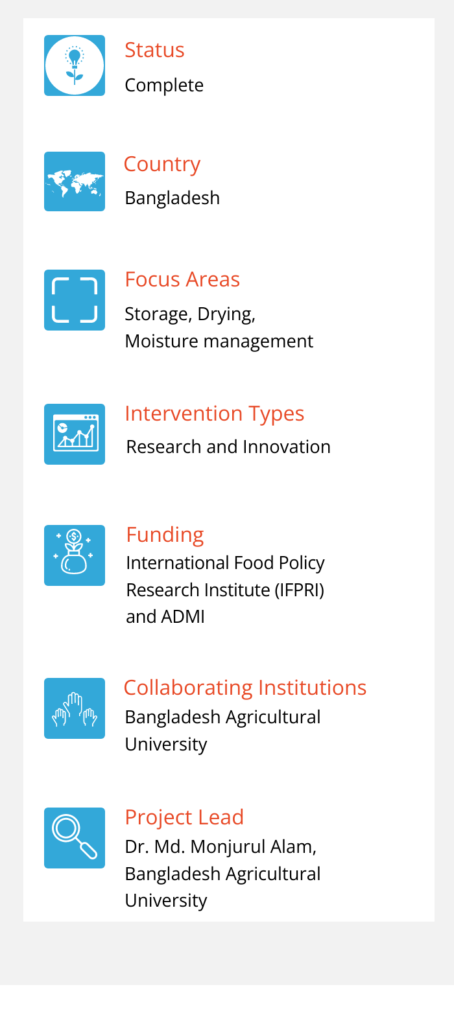
In Bangladesh, farmers sell about one-third of their harvested paddy just after harvesting, store another one-third for sale after two to three months, and store the remaining one-third for house hold consumption over the next six months. This pattern of sales and home consumption means that the majority of the country’s grain is stored at the farm level. On-farm storage may occur in jute sacks, woven dole, loosely fitted plastic drums, metallic bins, or open mounds on the floor. Storage at husking mills is typically in jute bags in open warehouses. Some automatic or semi-automatic mills have more modern storage facilities, but the capacity is very low,and only a small share of privately owned grain is stored in modern silos.
The Government of Bangladesh’s Modern Food Storage Facilities Project (MFSP) aims to improve storage of the country’s rice supply. While this would improve the storage of publicly procured and distributed rice, a considerable amount of the country’s paddy crop is stored in private rice mills or remains in possession of farmers. Reducing losses in these locations would increase the amount of grain available for consumption.
One path to addressing storage losses in the private sector could be to encourage private off-farm storage by millers or other intermediaries using low cost, hermetic storage cocoons, possibly in combination with warehouses (go downs or capacity of local storage depots). This project was designed to demonstrate the use and functionality of hermetic cocoons and train practitioners in their use.
Researchers at Bangladesh Agricultural University are testing large-scale off-farm hermetic grain storage techniques to determine the feasibility and effectiveness of these options for long-term storage. Several 5-ton capacity hermetic cocoons have been set up alongside traditional rice storage practices for a period of 4 months at the Moti Auto Rice Mill, a private rice mill. The specific objectives of this study are:

Researchers take regular readings for oxygen, carbon dioxide, moisture and humidity levels. The project will include use of multiple cocoon technologies differing by material (1250g/m2PVC; 205g/m2laminated PE; and 97.5g/m2PE), and placement (indoors or exposed). The capacity of the cocoons will be 5 tons. Paddy will be dried to a moisture content of between 12 to 14 percent (current miller practice), placed in 50 kg jute bags, and stored in five different technologies.
Engineering performance of the different cocoons will reflect the effectiveness of the technology-training, will be shared in the closing training to help trainees understand the impact of the technologies, and will inform the content of future training and technology transfer. Performance parameters to measure as part of this demonstration and training are:
Two rounds of experiments took place, to allow comparison of results in two different climatic seasons—one following the Amman storage season (January to April) and one following the more rainy and humid Boro storage period (July to September).

ADM Institute for the Prevention of Postharvest Loss
1301 W. Gregory Dr.
60 Mumford Hall
Urbana IL 61801
+1 217-333-5115